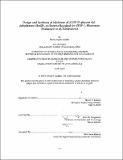Design and synthesis of inhibitors of dTDP-D-glucose 4,6-dehydrate (Rm1B), and enzyme required for dTDP-L-rhamnose production in M. tuberculosis
Author(s)
Kadaba, Neena Sujata, 1981-
DownloadFull printable version (6.943Mb)
Other Contributors
Massachusetts Institute of Technology. Dept. of Biological Engineering.
Advisor
John M. Essigmann.
Terms of use
Metadata
Show full item recordAbstract
The purpose of this work is to probe the dTDP-L-rhamnose pathway in an effort to develop small molecule inhibitors that could act as therapeutics for Mycobacterium tuberculosis. The necessity for newer, more effective treatments for tuberculosis is growing, as the bacteria evolve resistance to traditional treatments. In an effort to develop more effective and perhaps more abbreviated courses of treatment, a plan was developed to investigate a pathway involved in cell wall biosynthesis as a promising target: the dTDP-L-rhamnose pathway. This pathway plays an essential role in linking the peptidoglycan and arabinogalactan portions of the mycolic acid-arabinogalactan-peptidoglycan complex, a significant part of the mycobacterial cell wall. The mounting level of biochemical understanding of this pathway and its importance in bacterial cell wall biosynthesis indicates that it is not only a relevant target but also an accessible one. Of the four enzymes crucial to this biosynthetic pathway, one was chosen as the primary focus: dTDP-D-glucose-4,6- dehydratase (RmlB). There are 3 steps in the reaction mechanism of RmlB: oxidation of the C4 position of dTDP-D-glucose to form a 4-keto structure, dehydration of the C6 position via the elimination of water and a subsequent reduction to result in a 6-deoxy product. Crystal structures of this particular enzyme, dTDP-D-glucose 4,6-dehydratase (RmlB), complexed with single substrates or substrate analogs have provided a foundation for these studies, enabling the rational design of a small library of potential inhibitors. Twelve mechanism-based inhibitors of RmlB are proposed. These compounds reflect the current understanding of the mechanism and mimic the sugar portion of the sugar-nucleotide substrate at various steps throughout the reaction mechanism. Each of the proposed inhibitors is designed to inhibit one of the specific steps of the mechanism. While the intention of this project is to synthesize each compound in this library from commercially available starting materials in 15 steps or less, the primary goal of this particular dissertation is to synthesize 3 of the 12 proposed inhibitors from the commercially available starting material 1,5-anhydro-D-glucitol. The long term goal of this work is to produce these compounds in significant amounts in order to test their efficacy in an animal model of mycobacterial infection.
Description
Thesis (S.M. in Molecular and Systems Toxicology)--Massachusetts Institute of Technology, Biological Engineering Division, 2003. Vita. Includes bibliographical references (leaves 60-62).
Date issued
2003Department
Massachusetts Institute of Technology. Department of Biological EngineeringPublisher
Massachusetts Institute of Technology
Keywords
Biological Engineering.